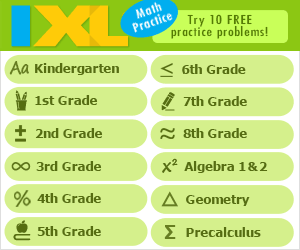6th Grade English Language Arts - Language Standards
To work on sixth grade language standards, click on the numbers below to visit pages of internet resources for each of the learning standards.
Checks for Understanding are at the top of this page. Scroll down to find internet resources related to the State Performance Indicators (SPIs).
Checks for Understanding (Formative/Summative Assessment)
0601.1.1 Parts of Speech - Know and use appropriately the meaning, forms and functions of nouns (e.g., collective nouns, nouns as objects, predicate nouns), pronouns (e.g., proper pronoun case; objects of prepositions; agreement with antecedents in person and number; indefinite, relative, and demonstrative pronouns), verbs (e.g., agree with the subject in person and number, action verbs that take objects, linking verbs, helping verbs, verb phrases, verb tenses, regular and irregular verb forms), adjectives (e.g., predicate adjectives, comparative and superlative forms), adverbs (e.g., negatives, forms of comparative and superlative phrases), conjunctions (e.g., coordinating, subordinating), interjections, and prepositions (place prepositional phrases correctly according to the words they modify within the sentence). 0601.1.2 Correct Usage Errors - Recognize and correct usage errors (e.g., double negatives, troublesome word pairs {to/to/two, their/there/they're, its/it's, sit/set, lie/lay, affect/effect, sit/set, lie/lay, may/can, leave/let, teach/learn, accept/except, capitol/capital, principle/principal, between/among}). 0601.1.3 Capitalization - Use capitalization correctly (e.g., proper adjectives, within quotations). 0601.1.4 Use Punctuation Marks - Demonstrate the correct use of commas (e.g., after introductory words, to set off appositives and interrupters, before a coordinating conjunction joining independent clauses to form compound sentences), colons (e.g., in business letters, preceding a list of items), semicolons (e.g., to combine sentences), quotation marks (e.g., with explanatory material within the quote, proper use with end marks), and apostrophes (to form singular and plural possessives). 0601.1.5 Spell - Spell correctly high–frequency words, commonly misspelled words (appropriate to grade level), and words commonly used in content specific vocabulary. 0601.1.6 Run On Sentences - Correct run on sentences (e.g., use punctuation, conjunctions, or other means to separate the elements of a run-on) and sentence fragments (i.e., supply the missing sentence elements). 0601.1.7 Phrases and Clauses - Identify and use adjectival and adverbial phrases and clauses. 0601.1.8 Appositives - Identify and use appositives and appositive phrases. 0601.1.9 Infinitives - Identify and use infinitives and infinitive phrases. 0601.1.10 Clauses - Determine the difference between independent and subordinate clauses. 0601.1.11 Sentence Types - Recognize and differentiate between simple and compound sentences. 0601.1.12 Sentence Structure - Identify the structure in imperative and interrogative sentences. 0601.1.13 Use Various Resources - Use printed and electronic dictionaries, thesauruses, and glossaries to determine the pronunciation, spelling, and part of speech words; to clarify meaning and improve understanding of words (including connotation and denotation); and to distinguish among contextually appropriate synonyms and definitions. 0601.1.14 Homonyms, Antonyms, and Synonyms - Define and recognize word synonyms, antonyms, and homonyms. 0601.1.15 Roots - Identify and define English words derived from Latin and Greek words that form common roots (e.g., audio, auto, malus) and recognize English words that are based on them (e.g., audible, autobiography, malice). 0601.1.16 Cultural and Regional Effects - Recognize and appreciate cultural and regional differences signaled by word usage and vocabulary. 0601.1.17 Foreign Phrases - Explore common phrases and terms from other languages commonly used in English (e.g., RSVP, deja vu, faux pas, du jour, bon voyage). State Performance Indicators
SPI 0601.1.1 Nouns and Pronouns - Identify the correct use of nouns (i.e., common/proper, singular/plural, possessives) and pronouns (i.e., agreement, subject, object) within context. SPI 0601.1.2 Verbs - Identify the correct use of verbs (i.e., action, linking, regular/irregular, agreement) within context. SPI 0601.1.3 Adjectives and Adverbs - Identify the correct use of adjectives (i.e., common/proper, comparative forms) and adverbs (i.e., comparative forms) within context. SPI 0601.1.4 Prepositional Phrases - Identify the correct use of prepositional phrases (place prepositional phrases correctly according to the words they modify within the sentence) within context. SPI 0601.1.5 Conjunctions - Identify the correct use of conjunctions (i.e., coordinating and subordinating) and interjections within context. SPI 0601.1.6 Punctuation Marks - Choose the correct use of quotation marks, commas (i.e., in direct quotations, with explanatory material within the quote, proper use with end marks) and colons (i.e., in business letters, preceding a list of items). SPI 0601.1.7 Combining Sentences - Identify within context a variety of appropriate sentence-combining techniques (i.e., comma + coordinating conjunctions, introductory words, appositives, interrupters). SPI 0601.1.8 Correct a Run-On Sentence - Select the most appropriate method to correct a run-on sentence (i.e., conjunctions, semicolons, and periods to join or separate elements). SPI 0601.1.9 Usage Errors - Recognize usage errors occurring within context (i.e., double negatives, troublesome words {to/to/two, their/there/they're, its/it's, sit/set, lie/lay, affect/effect, sit/set, lie/lay, may/can, leave/let, teach/learn, accept/except, capitol/capital, principle/principal, between/among}). SPI 0601.1.10 Plurals and Possessives - Identify the correct spelling of plurals and possessives. SPI 0601.1.11 Subject-Verb Agreement - Identify sentences with correct subject-verb agreement (person/number) within context. SPI 0601.1.12 Commas - Identify the correct use of commas (i.e., compound sentences, coordinating conjunctions, introductory words, appositives, interrupters) within context. SPI 0601.1.13 Interjections - Choose the appropriate interjection to complete a sentence. SPI 0601.1.14 Synonyms, Antonyms, and Homonyms - Select appropriate synonyms, antonyms, and homonyms within context. SPI 0601.1.15 Multiple-Meaning Words - Use context clues and prior knowledge of roots and affixes to determine the meaning of multi-meaning words. SPI 0601.1.16 Unfamiliar Words - Use context clues and prior knowledge of roots and affixes to determine the meaning of unfamiliar words. SPI 0601.1.17 Use Resources - Use dictionaries, thesauruses, electronic sources, and glossaries as aids in determining the meaning of unfamiliar words. SPI 0601.1.18 Spelling - Identify correctly and incorrectly spelled words in context. SPI 0601.1.19 Vocabulary - Recognize and use grade-appropriate and content-specific vocabulary within context. SPI 0601.1.20 Root Words - Use knowledge of root words, affixes, syllabication, and/or spelling patterns as aids in determining meaning within context. Review Help Resources to help review Sixth Grade English Language Arts standards
Search Internet4Classrooms

Custom Search






